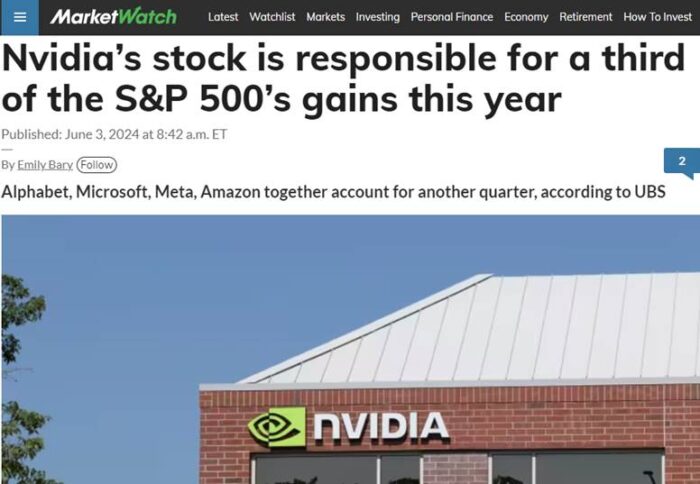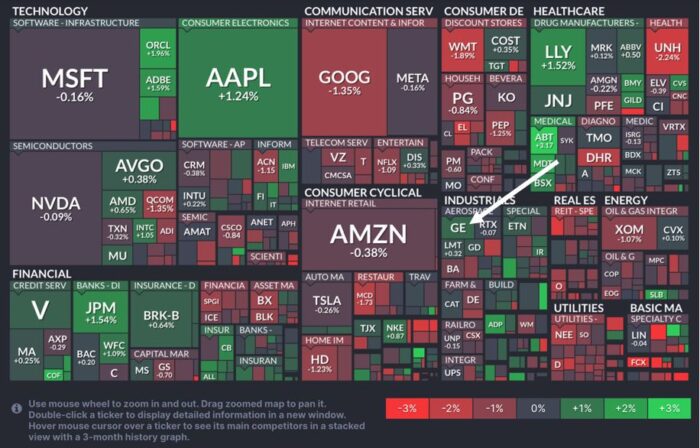by Thomas Brueckner, CLTC
Benjamin Graham, the mentor that Warren Buffett first met in 1947, championed diversification across multiple asset classes. That wisdom is entirely supplanted by the weighted composition of today’s S&P 500 index.
Many of you probably heard about the “Magnificent Seven” last year. Those seven companies were responsible for pulling the other 493 firms in the S&P 500 from the mundane return of 7.8% to a calendar year increase of 24.2%. In this article from Market watch, the authors point out that a single company, Nvidia, has been responsible for a full 34% of the entire index’s year-to-date gain in 2024. Four other companies, Microsoft, Meta, Amazon, and Alphabet have been responsible for another 26% of that gain. Do the math. That means that 60% of the market’s return has come from just five of the 500 companies that make up the S&P 500 index. One percent of those firms are responsible for 60% of the index’s year-to-date gains. Think about that for a minute and let the consequences sink in: When that “egregiously overbought” sector of the economy takes its long-overdue—and much-predicted—bloodbath a la the 2000-2002 dot-com NASDAQ implosion of -63%, will it matter how “fundamentally strong” the other 495 companies are? If the other 99% of the index benefits from the positive pull of those five companies, what happens to them when that pull becomes dramatically negative? This is the market we find ourselves in today, and it’s markedly different than the one our parents and grandparents were invested in. More importantly, it is absolutely not a reflection of the dwindling strength of our domestic economy.

The Steadily Shrinking Economy
All of this effusive market euphoria has been taking place even as we’ve seen declines in the Conference Board’s Index of Leading Economic Indicators in 24 of the last 26 months. Commercial real estate, in particular the vacant office space in major cities, is facing a generational implosion, likely taking dozens more regional banks down with it. New York City alone has the vacancy equivalent of 30 empty Empire State Buildings. Globally, the plummeting price of oil, diesel, copper, and other commodities is signaling weak economic demand, and the high probability of a global recession.
The May Jobs Report that came out a week ago Friday, via the Bureau of Labor Statistics, claimed that the economy created 272,000 jobs, far more than the 185,000 that economists had been expecting, yet unemployment rose to 4% once again, a level it hadn’t seen in over two and a half years. Looking inside those numbers, we actually created 286,000 part-time jobs, while losing 625,000 full-time jobs. Overall, the Household survey, separate from the BLS report, showed that 408,000 people lost their jobs in May. It seems the BLS acronym really does have one too many letters in it.

What about the residential housing market? Analysts are in agreement that in most parts of the country the market is effectively dead. The few homes that hit the market each month are subject to a bidding war from cash buyers, yet anyone else needing a mortgage is reluctant to trade-in their 2.875% interest rate for a new rate north of 7%. This has now spilled over into the job relocation market, where those being offered new positions out of state are rarely able to accept them once they realize the dramatic increases to their future housing costs of those new higher mortgage rates.
All Eyes on the Fed
At the beginning of this year, we were promised six rates cuts before year end. As of this past Wednesday’s latest Fed decision to leave rates unchanged, that forecast has dropped to one, if any, before the end of the year. If the Federal Reserve no longer has the backs of investors, why are investors still hanging on for the possibility of multiple rate cuts? What many people miss in the monthly CPI and PPI reports, is that inflation is still increasing, it’s just increasing at a slower pace. The most recent reading at the Consumer level is 3.3%, even as the Federal Reserve’s target rate remains 2%. As persistently “sticky” as inflation has been this year, it’s now become obvious that the Fed won’t meet that goal any time soon, probably not until 2026.
Geopolitical Threats are Everywhere
In his recent testimony before Congress, FBI Director Christopher Wray told our Congress that he’s never been more concerned for the Homeland in his entire law enforcement career: “As I look back over my career in law enforcement, I would be hard-pressed to think of a time where so many threats to our public safety and national security were so elevated all at once,” Wray told lawmakers. Citing the massive influx of new immigrants that have come across our southern border in the last 3½ years, he specifically singled out the number of single, military-aged men who have applied for asylum at the southern border, just this year alone. These individuals originate from a hundred countries, are roaming the country freely, we don’t know their whereabouts, no one is tracking their activities, and they’re allowed to stay here until their asylum hearing date comes up three to five years from now. While some are turned away for being on the terror watchlist, it is estimated that many others have gotten through undetected. What are they up to, and will whatever they’re planning be random, coordinated or synchronized, and what will their timing be? Logic dictates that we’ll have some type of major incident, perhaps multiple events, later this year before the election, for maximum societal disruption.
What’s the Smart Play Now?
When asked about the best time to take a profit, the late Scott Minerd replied, “When there is one. Until then, your gains are only on paper.” Locking in your Nvidia-assisted gains is a smart move even if you think their share price could go even higher, and when done inside an IRA or 401(k) is not a taxable event.

Above is a Heat Map of the S&P 500 index through last Friday. It shows the relative size of each of the companies in the index, compared to other companies in other economic sectors. Thirty years ago, if you wanted to own one company that was broadly diversified across multiple sectors of the economy, one that manufactured appliances, aircraft engines, avionics for the space shuttle and submarine warfare, and even had a strong market share in long-term care insurance, you bought General Electric. Note the size of GE (see arrow) in market capitalization, compared to the Magnificent Seven, and ask yourself three questions:
First, are the imbalances that you see in the chart above a true representation of the health of the overall economy?
Secondly, will “sound management” at the other 495 companies in that index matter when technology and internet company stocks implode in response to a dreaded stimulus, an EMP attack, solar storms, a horrific earnings quarter, an SEC investigation, or the unexpected death of a key CEO? These are just some of the many arguments made in favor of diversification by the Benjamin Grahams of the world, men whose wisdom we seem to have forgotten.
Here’s the third question: If cash is paying over 5% in most money market accounts, might this be a good time to take some risk off the table, at least until after the election?
Your answers to these three questions could be as impactful to your pending retirement as ignoring them entirely.

“…A sound investment is one which promises safety of principal and an adequate return. Anything not meeting these criteria is speculation…”
—Benjamin Graham